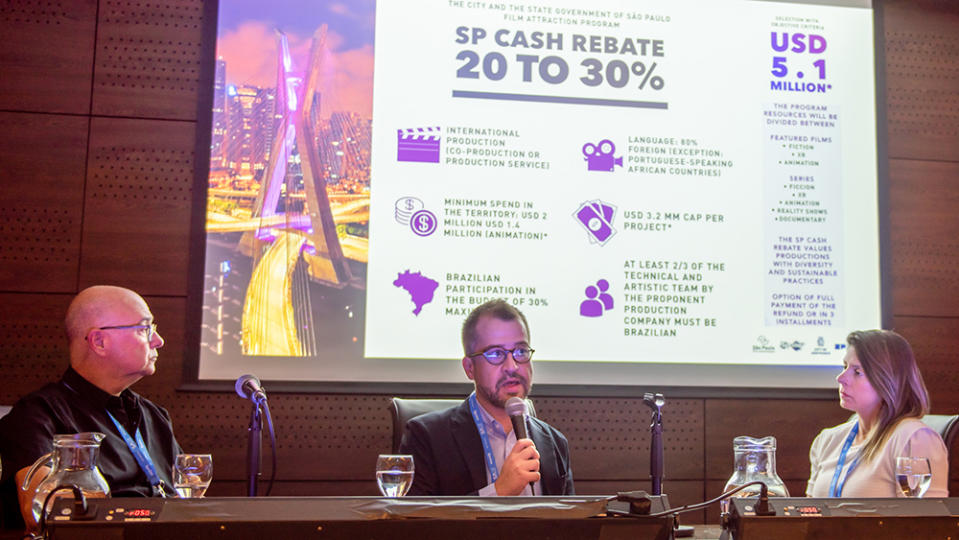Brazil Turns to International Co-Production and Global Streamer IP Regulation as Near $1 Billion of Public Funding Begins to Hit the Sector

BUENOS AIRES — Brazil is beginning to come back as Latin America’s production powerhouse. At Ventana Sur on Monday, representatives of key federal, state and city authorities as well as a leading producer outlined some of the directions the giant would like to take on its return.
That matters. The two words repeated most by the four panelists on a first-day round table at Ventana Sur, Overview Of the Brazilian Audiovisual Industry and Opportunities For Collaboration With São Paulo, were “international co-production.”
More from Variety
'Roman's Circuit's' Escala Humana Prepping CIA Drama Series 'Golpe' (EXCLUSIVE)
'Star Trek: Discovery,' 'Halo' Among Paramount+ Lineup at CCXP Brazil
Prime Video Snaps Up Gabriela Tagliavini's 'Tequila Repasado' (EXCLUSIVE)
Brazil, for other Latin American powers and partners in Europe, can once more bring a lot to the table.
On May 11, the Paulo Gustavo Law, a post-pandemic recovery initiative, released R$2.8 billion ($571 million), for Brazil’s audiovisual sectors. That has now been delivered to Brazil’s 27 states and 5,000 cities, for them to use as they wish, whether in production and distribution incentives or creation of a local knowledge economy, André Ricardo Araújo Virgens, general coordinator of Brazil’s National Audiovisual Secretariat, part of its Ministry of Culture, told Variety at Ventana Sur.
Policy is part of a Pacto Federal drive towards decentralization, one of president Lula’s passions.
Liliana Crocco, co-ordinator of São Paulo State’s culture promotion unit, confirmed that São Paulo – State and cities – had received R$300 million ($61.2 million) from the Paulo Gustavo Law and was “finalizing financing lines.”
São Paulo State has one of the largest production outputs in Brazil but even so it wants to grow, conceiving film and TV as not only culture but robust industry, Crocco added.
Thanks to its established incentives and the Law, it is tripling direct subsidies for the sector, she confirmed.
Brazil’s Fundo Setorial do Audiovisual, its central subsidy fund, is plowing a further RS1 billion ($204.1 million) for 2022 and another R$1 billion for 2023 into the audiovisual sector, making for a total financial injection for 2023 of R$4.8 billion ($972 million).
Payment of those FSA incentives is “on the way, though as yet not finalized,” said Araújo Virgens, with calls for submissions to various funding lines having been launched.
Framing an exemplary partnership between São Paulo State and City Town Hall, São Paulo now manages an $8 million cash incentive to attract international shoots across the state, offering rebates of 20%-30% of qualifying expenditure capped at R$3.2 million, said Luiz Toledo, director of investments and strategic partnerships, at São Paulo City promotion agency Spcine.

The cash incentive has proved immensely popular, its budget being exhausted in less than 24 hours, attracting shoots that have invested a total $50 million in São Paulo, he added.
One large question is whether a third-phase São Paulo rebate will be announced soon and if it will have any new criteria.
A key to these investments, the panelists agreed, is international co-production.
“We’re in a moment of change, of continual change, of reconstruction, which means we’re taking up once more initiatives which were halted in the last few years,” said Araújo Virgens. A case to point: the ratification of a new co-production agreement with France.
Other initiatives are pretty well new, such as a quadrilateral co-production agreement between the four countries of Mercosur: Brazil, Argentina, Uruguay and Paraguay. “If all goes well, this agreement will be signed at presidents at a Mercosur summit next week in record time,” Araújo Virgens said.
“Our challenge is co-production,” a policy firmly supported by Joelma Gonzaga, Brazilian Audiovisual Secretary, he said, and also co-ordinated with agency Ancine.
With Mercosur as “the starting point,” joined by other agreements negotiated now, “we can reach other segments with greater strength such as not only co-production but distribution. I hope that very soon we’ll be able to announce new elements to this issue, which is a more effective practice,” he added, observing that co-production can create the base for a whole audiovisual sector ecosystem, he concluded.
“How many people here in this room have made international co-productions?” asked Roni, a partner-producer at Ocean Films, behind Brazilian Oscar entry “Little Secret,” and a board member of Bravi, Brazil’s independent producers’ assn.with around 7,000 active members.
Just a few hands went up. “Brazil’s behind a lot of smaller countries because of the size of its [internal] market,” Roni said. “We have a responsibility to grow, with our infrastructures, attentive to business opportunity,” he added, citing a fam trip to Japan and Korea which allowed producers to understand which kind of projects could be presented to possible partners there, “which is very specific.”
Co-production is key, allowing partners to retain part of IP, and compete with an international industry, said Toledo.
Roni noted that Brazil was about to negotiate IP regulation, as these services are opening up to co-production, so to sharing IP.
São Paulo’s cash incentive allows Brazilian companies to take up to 30% of cash rebate winners, opening the doors to minority co-production, Toledo noted.
Expect ever more and higher-end larger scale Brazilian projects to begin to hit Ventana Sur.
Best of Variety
Sign up for Variety’s Newsletter. For the latest news, follow us on Facebook, Twitter, and Instagram.

